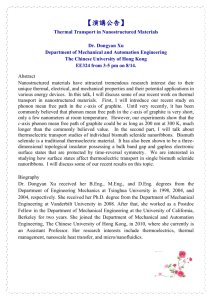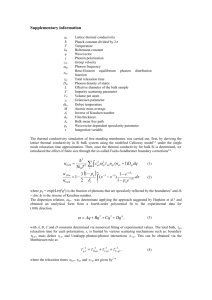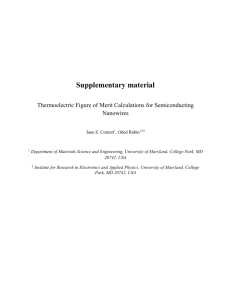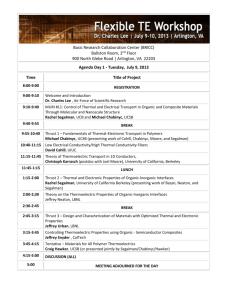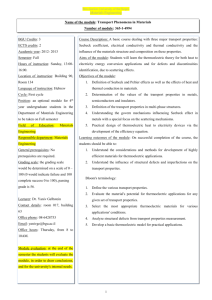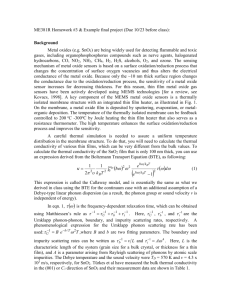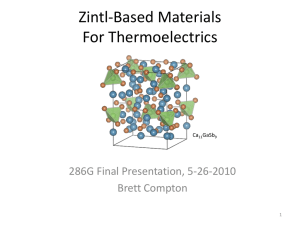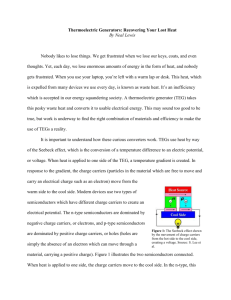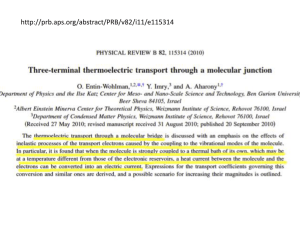Thermoelectric slides powerpoint
advertisement
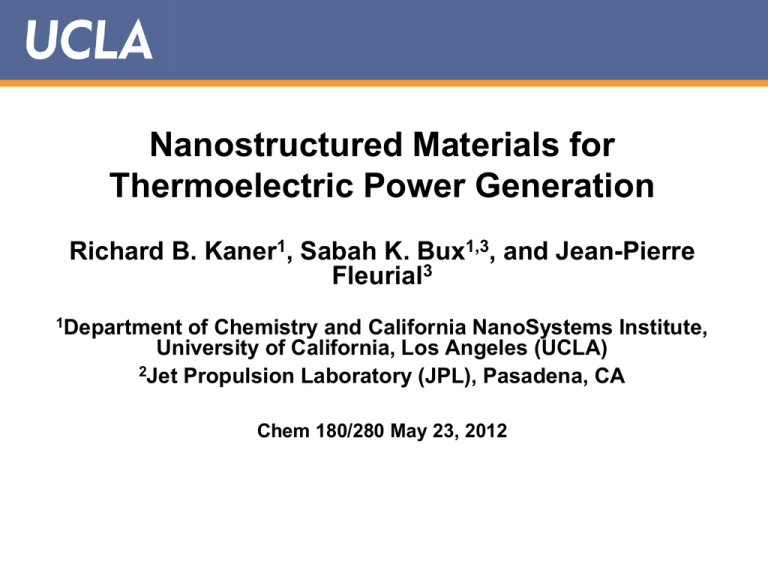
Nanostructured Materials for Thermoelectric Power Generation Richard B. Kaner1, Sabah K. Bux1,3, and Jean-Pierre Fleurial3 1Department of Chemistry and California NanoSystems Institute, University of California, Los Angeles (UCLA) 2Jet Propulsion Laboratory (JPL), Pasadena, CA Chem 180/280 May 23, 2012 Why Thermoelectrics? • NASA’s deep space missions – Not enough solar flux beyond Mars • Compact, solid-state devices – Survives the vibrations from launch • Long lifetimes – Voyager ~30 years • Space and terrestrial applications http://www.its.caltech.edu/~jsnyder/thermoelectrics Current NASA Missions • Radioisotope Thermoelectric Generators (RTGs) powers deep space probes and rovers RTG Cassini - Saturn http://saturn.jpl.nasa.gov/; Mars Science Laboratory http://marsprogram.jpl.nasa.gov/msl/ Thermoelectrics Cooling Heat Source + h+ h+ e- e- - h+ h+ e- e- Heat Sink Heat Rejected Seebeck Effect Peltier Effect Power Generation Electronic Cooling/Heating Terrestrial Applications of Thermoelectric Devices • Thermoelectric cooling/heating Heated and cooled car seats • Waste heat recovery http://www.foursprung.com/2006_10_01_archive.html http://www.themotorreport.com.au/23040/bmw-and-nasa-teaming-up-to-devise-regenerative-exhaust-system/ Thermoelectric Generator Thermoelectric Figure of Merit l = llattice + lelectronic S = DV/DT S, Seebeck coefficient s , electrical conductivity l, total thermal conductivity T, temperature Thermoelectric Materials σ Arbitrary Units S S2σ 1019 Insulators Semiconductors Metals Current State of the Art Bulk Materials n-type thermoelectric materials p-type thermoelectric materials The maximum ZT is about 1.2 over the entire temperature range for bulk materials Phonon Mean Free Path and Thermal Conductivity in Si 1000 K • Phonon mean free path (MFP) spans multiple orders of magnitude • 80% of the k at 300 K comes from phonons that travel less than 10 mm • 40% of the k at 300 K comes from phonons with MFP<100 nm 300 K 9 Dresselhaus et al Synthesis Starting Materials High purity elements (e.g. Si, Ge) 99.999% Ball Milling Nano Bulk Powder Unfunctionalized nanostructured powders Hot Uniaxial Compaction Nano Bulk Pellets Pellets 99% of theoretical density Mechanical Alloying/High Energy Ball Milling • Nanostructured materials are formed from constant welding and fracturing • Scalable technique –Processing conditions must be adapted for each materials • Mechanochemical process http://products.asminternational.org/hbk/index.jsp Compaction Hot uniaxial compression • Need dense pellets for thermoelectric measurements • Sintering of nanoparticles ~80-95% of melting point 12 Nanostructured Si/SiGe Phase Pure Si, Crystallite Size 15 nm a 4000 NSN30_24 15.5 nm crystallites JCPDS Si 00-027-1402 TEM: Nano Si Aggregates b Intensity 3000 2000 1000 100 nm 0 20 40 60 80 100 Degrees Two Theta Cu K c d Ion milled, 99% dense pellet with nanostructured inclusions Aggregate made up of small nanocrystallites 20 nm 10 nm Bux, Dresselhaus, Fleurial, Kaner, et al. Adv. Funct. Mater. 2009, 19, 2445 Thermal Conductivity: Bulk Nanostructured Silicon 910 810 710 l (mW/c mK) Heavily Doped n-type Si Single Crystal 610 510 410 310 n-type Nano Si 210 110 10 200 700 T (K) 1200 Up to 90% reduction in the thermal conductivity Lattice Thermal Conductivity 910 810 710 kL (mW/cm.K) Heavily Doped n-type Si Single Crystal 610 510 410 310 n-type Nano Bulk Si 210 110 10 200 400 600 800 T (K) 1000 1200 1400 Bulk Nanostructured Materials • Increase phonon scattering via interfacial scattering (reduce thermal conductivity) Phonon Electron • Minimize electron scattering (maintain electrical properties) Picture courtesy of Gang Chen (MIT) Nanoparticles Seebeck Seebeck Coefficient ( m V/K) 0 Heavily Doped n-type Si Single Crystal -50 -100 n-type Nano Bulk Si -150 -200 -250 200 400 600 800 T (K) 1000 1200 1400 Resistivity of Nano-bulk Silicon Electrical Resistivity (m .cm) 1.4 1.2 1.0 0.8 0.6 0.4 Heavily Doped n-type Si Single 0.2 0.0 200 400 600 800 T (K) 1000 1200 1400 0.8 ZT of Nano-Bulk Si 0.7 0.6 n-type Nano Bulk Si ZT 0.5 0.4 0.3 0.2 0.1 Heavily Doped n-type Si Single Crystal 0.0 200 400 600 800 T (K) 1000 1200 1400 Over 250% increase in the ZT over single crystals! p-type Nanobulk Si • Substantial reductions in thermal conductivity Lattice Thermal Conductivity (mW/cmK) • Same process of high energy ball milling applied to ptype Si 600 Heavily doped 'single crystal' Si 500 Heavily doped 'nanobulk' Si 400 300 200 100 0 200 400 600 800 T (K) 1000 1200 1400 Bux et al. Mater. Res. Soc. Symp. Proc. (2009), 1166, 1166-N02-04 Conclusions • Ball milling can be used to decrease the particle size of Si • ZT increases by a factor of ~250% due to the decrease in thermal conductivity • This method can be applied to SiGe alloys such as those used in RTG generators for space applications 21

